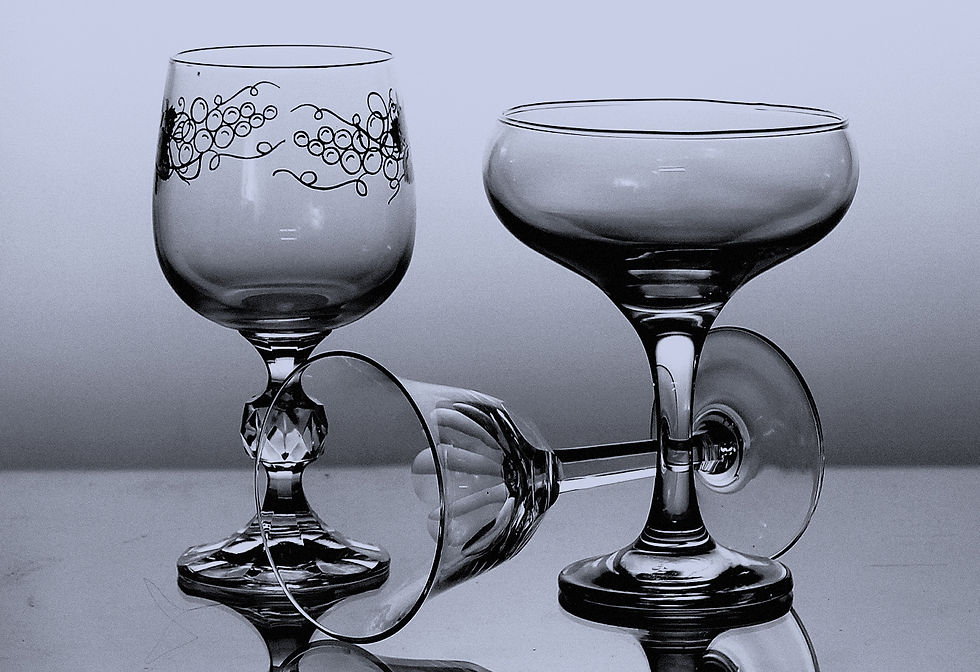What's In A Wine Glass - Wine Glasses 101
- Wine Hobbyist
- Jan 9, 2024
- 3 min read
As if deciding what dish should be served or what wines to pour were not enough, the question of what wine glass should be used, especially if you are serving several wines at a dinner, may also creep its weary head.

As selecting the proper stemware for wine could be crucial to enhance the overall experience, this post provides an overview of the different types of wine glasses you can encounter and what wine styles thrive within them.
Wine Glasses 101
Red Wine Glasses:
These glasses are more extensive to allow aeration, enhancing red wines' bold flavours and aromas.
Common variety named glasses you could encounter are:
Bordeaux - these glasses are tall, the tallest of red wine glasses, with a broad bowl. The distance from the wine to the rim of the glass allows for more oxygen, which in turn softens the tannins. These glasses are used for bigger and bolder red wines such as Cabernet Sauvignon, Merlot, Tannat, and Malbec.
Burgundy - these glasses have an extremely wide bowl. They are ideally shaped to allow aromas to hit the nose, and guide the wine to the middle of the palate. Though these are called Burgundy glasses, you can use them for more than Pinot Noir. Use them for other lighter-bodied red wines such as Barbera, Cinsault, and Gamay for example.
White Wine Glasses
White wine glasses are typically smaller than red wine glasses. They are more U-shaped to preserve white wines' crispness and delicate aromas. Be forewarned however that you could run into variety-based white wine glasses too (Riesling, Chardonnay, and Sauvignon Blanc), but it is not as commonly seen as red wine variety glasses.

Stemless Wine Glasses
Just as it sounds, these wine glasses do not have a long stem at the bottom; instead, they have flat bottoms like a regular drinking glass. The bowl is wide to help with aeration, but these glasses come at a disadvantage. Stemless glasses force you to hold the bowl of the glass to drink the wine. This means your body heat, cascaded through your hands, will undoubtedly change the wine's temperature prematurely, lessening the overall experience.
Sparkling Wine
People will serve sparkling wine in flutes and white wine glasses.
Flutes rose to fame as a sparkling wine glass as it was said to preserve the bubbles because of its narrow shape. However, if a large part of the beauty of wine is smelling it, why use a glass that will stifle that, such as a flute? For this reason, it is now common to see sparkling wine, especially traditionally made sparkling wine, served in a white wine glass. Using a white wine glass with a wider bowl lets you capture the autolytic/brioche, apple, and pear characteristics of an exquisitely made sparkling wine.
Dessert Wine Glasses
These are smaller than standard wine glasses to elevate the intense flavours of sweet and fortified wines like Port, Madeira, and Sauternes.
Universal Wine Glasses
These are versatile glasses designed for both red and white wines, with a bowl shape that balances aeration and the preservation of a wine's aroma. For the record, there is no shame in this game. I have a few sets of universal wine glasses for ease, and they come in handy, especially when doing tasting research.
This guide will prepare you for the glassware you could encounter, and we highly encourage, if the opportunity arises, to try one wine in multiple glasses to see and note the difference for yourself.



Comments